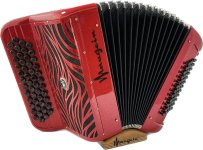I‘m very tempted to get an extremely compact 4-row C CBA - I have my eyes on one particular model. But I’m curious to hear from other experienced piano accordionists re how you found picking up the fingering. Was it a challenge? Did it take an awful lot of practice? How are you getting on? Are you happy you tried it or do you regret it? Any tips re things to do or avoid?
I’ve played piano accordion for not far off 50 years since I was very tiny. Sadly I’ve had a progressive neurological disease since I was 22. But do still play as much as I can. I‘m now more likely to be playing my second compact 48 bass than my long term 72 bass - just easier for me to get out and manage. It’s also why I’d only consider a very compact CBA, most likely 60 bass.
An added complication is that my neurological disease means I’m often weaker down my right side. I recovered a lot of right hand control after effectively a stroke in 2004, helping by teaching myself an extremely difficult piano piece! But it is an ongoing issue. Which would make picking up new fingering harder. But that exercise alone might be good to keep my brain and hand control going as long as possible.
Anyway interested in hearing views. Thanks! If I do get a CBA box I’m thinking of getting the English language version of the Galliano complete method book, which includes fingering for C CBA.
I’ve played piano accordion for not far off 50 years since I was very tiny. Sadly I’ve had a progressive neurological disease since I was 22. But do still play as much as I can. I‘m now more likely to be playing my second compact 48 bass than my long term 72 bass - just easier for me to get out and manage. It’s also why I’d only consider a very compact CBA, most likely 60 bass.
An added complication is that my neurological disease means I’m often weaker down my right side. I recovered a lot of right hand control after effectively a stroke in 2004, helping by teaching myself an extremely difficult piano piece! But it is an ongoing issue. Which would make picking up new fingering harder. But that exercise alone might be good to keep my brain and hand control going as long as possible.
Anyway interested in hearing views. Thanks! If I do get a CBA box I’m thinking of getting the English language version of the Galliano complete method book, which includes fingering for C CBA.

